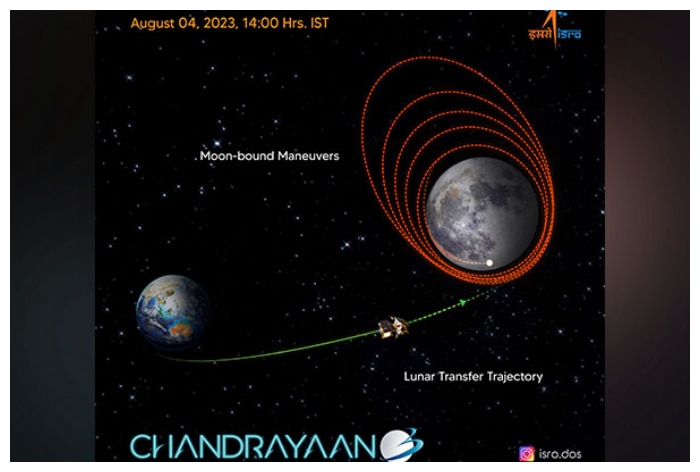
[ad_1]
Chandrayaan-3 is India’s third lunar mission which consists of an indigenous lander module (LM), propulsion module (PM), and a rover with the objective of developing and demonstrating new technologies required for inter-planetary missions.

Chandrayaan-3 Latest News: The Chandrayaan-3 spacecraft has covered about two-thirds of the distance to the Moon.
“The spacecraft has covered about two-thirds of the distance to the moon. Lunar Orbit Injection (LOI) set for Aug 5, 2023, around 19:00 Hrs. IST,” Indian Space Research Organisation (ISRO) tweeted Friday.
Chandrayaan-3 Mission:
The spacecraft has covered about two-thirds of the distance to the moon.Lunar Orbit Injection (LOI) set for Aug 5, 2023, around 19:00 Hrs. IST. pic.twitter.com/MhIOE65w3V
— ISRO (@isro) August 4, 2023
Chandrayaan-3, India’s third lunar exploration mission, was launched on GSLV Mark 3 (LVM 3) heavy-lift launch vehicle successfully from the Satish Dhawan Space Centre in Andhra Pradesh’s Sriharikota on July 14.
Chandrayaan-3 will make India the fourth country after the USA, China, and Russia, to land its spacecraft on the surface of the moon and demonstrate the country’s abilities for a safe and soft landing on the lunar surface.
Chandrayaan-3 is India’s third lunar mission which consists of an indigenous lander module (LM), propulsion module (PM), and a rover with the objective of developing and demonstrating new technologies required for inter-planetary missions.
It was successfully launched onboard LVM-3 on July 14, 2023, at 14:35 IST and is currently undergoing a series of orbit manoeuvres with the objective of reaching the moon’s orbit.
Chandrayaan-3 will take nearly 33 days from the launch date to reach the orbit of the moon. Upon landing, it will operate for one lunar day, which is approximately 14 Earth days. One day on the Moon is equal to 14 days on Earth.
Chandrayaan-3 components include various electronic and mechanical subsystems intended to ensure a safe and soft landing such as Navigation sensors, propulsion systems, guidance & control among others. Additionally, there are mechanisms for the release of Rover, two-way communication-related antennas and other onboard electronics.
The stated objectives of Chandrayaan-3 are safe and soft landing, rover roving on the moon’s surface, and in-situ scientific experiments.
The approved cost of Chandrayaan-3 is Rs. 250 crores (Excluding Launch Vehicle Cost).
Chandrayaan-3’s development phase commenced in January 2020 with the launch planned sometime in 2021. However, the Covid-19 pandemic brought an unforeseen delay to the mission’s progress.
Chandrayaan-3 is the ISRO’s follow-up attempt after the Chandrayaan-2 mission faced challenges during its soft landing on the lunar surface in 2019 and was eventually deemed to have failed its core mission objectives.
The key scientific outcomes from Chandrayaan-2 include the first-ever global map for lunar sodium, enhancing knowledge on crater size distribution, unambiguous detection of lunar surface water ice with IIRS instrument and more. The mission has been featured in almost 50 publications.
Moon serves as a repository of the Earth’s past and a successful lunar mission by India will help enhance life on Earth while also enabling it to explore the rest of the solar system and beyond.
There are about 54 female engineers/scientists who worked directly in the Chandrayaan-3 mission. They are associate and deputy project directors and project managers of various systems working at different centres.
Dr Ritu Karidhal Srivastava, one of the senior scientists at ISRO is leading the mission and played a key role in the success of the Mars Orbiter Mission. She holds a master’s degree in Physics from Lucknow University and an MTech from the Indian Institute of Science (IISc) in Bengaluru.
She joined ISRO in November 1997 and till now she has been a key member of many major space missions of ISRO. With more than 20 papers in international and national publications to her credit, she has been the operations director for many missions.
Ritu Karidhal is also called the Rocket Woman of India as she also played a major role during India’s Mars mission in her capacity as the deputy director of the project.
DR APJ Abdul Kalam, the former president of India, presented her the ISRO Young Scientist Award in 2007 and she has also been a TED talk speaker where she highlighted keynotes about the Mars Orbiter Mission.
Landing Expected On August 23
The journey from Earth to the moon for the spacecraft is estimated to take about a month and the landing is expected on August 23. Upon landing, it will operate for one lunar day, which is approximately 14 Earth days.
(With ANI inputs)

Don’t Miss Out on the Latest Updates.
Subscribe to Our Newsletter Today!

[ad_2]